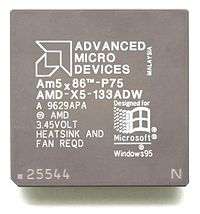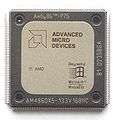Am5x86
The Am5x86 processor is an x86-compatible CPU introduced in 1995 by AMD for use in 486-class computer systems. It was one of the fastest, and most universally compatible upgrade paths for users of 486 systems.
 An early Am5x86-P75 for Socket 3, model ADW | |
| General Info | |
|---|---|
| Launched | November 1995 |
| Discontinued | 1999 |
| Marketed by | AMD |
| Designed by | AMD |
| Common manufacturer(s) |
|
| Performance | |
| Max. CPU clock rate | 133 MHz to 160 MHz |
| FSB speeds | 33 MHz to 50 MHz |
| Cache | |
| L1 cache | 4-way associative 16 KiB unified code and data, write-back or write-through. |
| L2 cache | Motherboard dependent |
| L3 cache | none |
| Architecture and classification | |
| Min. feature size | 0.35 μm |
| Instruction set | x86 (IA-32) |
| Physical specifications | |
| Cores |
|
| Package(s) |
|
| Socket(s) | |
| History | |
| Predecessor | Am486 |
| Successor | AMD K5 |
Introduced in November 1995, the Am5x86 (also known as 5x86-133, Am5x86, X5-133, and sold under various 3rd-party labels such as the Kingston Technology "Turbochip") is an Enhanced Am486 processor with an internally set multiplier of 4, allowing it to run at 133 MHz on systems without official support for clock-multiplied DX2 or DX4 486 processors. Like all Enhanced Am486, the Am5x86 featured write-back L1 cache, and unlike all but a few, a generous 16 kilobytes rather than the more common 8 KB. A rare 150 MHz-rated OEM part was also released by AMD.[1]
Since having a clock multiplier of four was not part of the original Socket 3 design (and that the 486 only have a single CLKMUL pin anyway), AMD made the 5x86 accept a 2x setting from the motherboard and instead operate at a rate of 4x. When using an Am5x86, the motherboard must be set to the 2x setting. The chip will actually physically fit into an older 486 socket such as a socket 1 or 2 or the original 168-pin 80486 socket, but doing this requires a replacement voltage regulator, since the AMD chip runs at 3.45 volts.
The combination of clock speed and the relatively large 16 KB write-back L1 cache allowed the 5x86 to equal or slightly exceed an Intel Pentium 75 MHz processor in integer arithmetic in benchmarks. (Real world performance varied, however, with later Windows operating systems and many FPU-sensitive games favoring the Pentium 75 MHz.) Also, because it was based on a pure 486 design, it was compatible with older systems, something its slightly faster rival, the Cyrix Cx5x86, had trouble with. The CPU was commonly overclocked to 160 MHz, thereby giving performance similar to that of a Pentium 90 MHz system. It has been reported that some individuals have successfully run the chip at 200 MHz; this would require a PCI-based system (due to the instability of VLB at high speed) and uncommon motherboards and cache RAM that could cope with a 50 MHz system bus. There are four main versions of the socketed version of this CPU, manufactured in different locations. There is the common ADW variety, as well as the later ADY, ADZ and BGC. The later models were the preferred versions of the chip, because they were rated for higher temperatures and thus more forgiving of overclocking.
The Am5x86 is also notable for the first-ever use of the controversial PR rating. Because the 5x86 was the equal of a Pentium 75 MHz processor in benchmarks, AMD later marketed the chip as "Am5x86-P75".
Sales of the Am5x86 were an important source of revenue for AMD at a time when lengthy delays in bringing the AMD K5 to production were threatening the company's profitability.
AMD manufactured the Am5x86 processor for ordinary PC systems until 1999. It was popular for entry-level desktop systems, appeared in many different notebook models, and also sold separately as an upgrade processor for older 486 systems. Several companies made upgrade kits which packaged an AMD 5x86 with a voltage regulator and socket converter, which allowed its use on virtually every socketed 486 motherboard ever produced. Several companies also provided upgrades for older 486 notebooks by replacing soldered 486 CPUs. The chips were even used on later Acorn RiscPC "PC card" second processors. The RiscPC's OpenBus memory interface was only 32 bit, which meant that the Pentium could not be easily interfaced to it. Intel's expensive Pentium Overdrive for 486 systems was a troublesome CPU, with many compatibility issues, and so was not used. The 5x86 therefore provided the acme of RiscPC Windows performance.
The chip remained in production for a long time, as it was a popular choice for use in embedded controllers. One derivative of the 5x86 family is the core used in the Élan SC520 family of microcontrollers marketed by AMD. This powered the original Cisco PIX.
 An Am5x86-P75 model ADZ
An Am5x86-P75 model ADZ-(486-CPU).jpg) A late Am5x86-P75 for Socket 3, model W16BGC
A late Am5x86-P75 for Socket 3, model W16BGC Surface-mounted Am5x86-P75, model V16BHC
Surface-mounted Am5x86-P75, model V16BHC
Features
CPU features table
Models
| CPU | Model number | Frequency | L1 Cache | FSB | Mult. | Voltage | TDP | Socket | Release date | Introduction price |
|---|---|---|---|---|---|---|---|---|---|---|
| Am5x86-P75 | X5-133 ADH | 133 MHz | 16 KiB | 33 MHz | 4 | 3.45 V | PGA-168 Socket 1 PGA-168 Socket 2 PGA-168 Socket 3 | 6 November 1995 | $93 | |
| X5-133 ADY | ||||||||||
| X5-133 ADW | ||||||||||
| X5-133 ADZ | ||||||||||
| X5-133 BGC | ||||||||||
| X5-133 W16BGC | ||||||||||
| X5-133 V16BGC | 3.3 V | |||||||||
| X5-133 W16BHC | 3.45 V | Surface mounted 208-pin SQFP on PGA-168 | ||||||||
| X5-133 V16BHC | 3.3 V | |||||||||
| X5-133 SFZ | ||||||||||
| Am5x86-P75+ | X5-150 ADW | 150 MHz | 16 KiB | 50 MHz | 3 | 3.45 V | PGA-168 Socket 1 PGA-168 Socket 2 PGA-168 Socket 3 | |||
| Am5x86-P100 | X5-160 ADZ | 160 MHz | 16 KiB | 40 MHz | 4 | 3.45 V | PGA-168 Socket 1 PGA-168 Socket 2 PGA-168 Socket 3 |
References
- Cassino, Mark (2011). "The AMD 5x86 Processor: X5-150". cpu-collection.de. Retrieved 14 November 2011.
- Shvets, Gennadiy (25 July 2016). "AMD 80486 microprocessor". CPU-World. Retrieved 25 July 2016.
- "The AMD 5x86 Processor". cpu-collection.de. 2011. Retrieved 14 November 2011.
- http://www.cpu-galerie.de/html/amd5x86.html#160ADZ
External links
| Wikimedia Commons has media related to AMD Am5x86. |